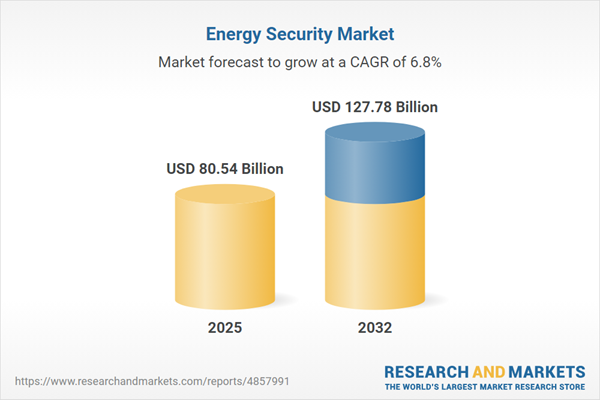Speak directly to the analyst to clarify any post sales queries you may have.
The Energy Security Market is advancing rapidly as organizations respond to rising geopolitical uncertainties, evolving digital threats, and the pressing need for resilient, sustainable energy frameworks. Senior leaders are prioritizing adaptable strategies that integrate advanced technologies and secure infrastructure across the global landscape.
Market Snapshot: Energy Security Market Growth and Opportunity
The Energy Security Market grew from USD 75.49 billion in 2024 to USD 80.54 billion in 2025 and is projected to reach USD 127.78 billion by 2032, reflecting a CAGR of 6.79%. This growth is driven by interconnected trends, including accelerating decarbonization, digital transformation, and increasing investment in distributed energy resources. Organizations across commercial, industrial, and utility segments are prioritizing robust security architectures and advanced monitoring to ensure uninterrupted energy access and operational resilience.
Scope & Segmentation
This report delivers comprehensive insight into the components, technologies, and regional dynamics shaping the Energy Security Market. Analysis is segmented to help leadership address supply chain complexity, regulatory shifts, and evolving risk profiles.
- Solution Types: Control systems (distributed control systems, programmable logic controllers), cybersecurity solutions (data protection, endpoint security, network security), monitoring solutions (remote equipment monitoring, SCADA), storage solutions (battery, thermal energy storage).
- Component: Hardware (actuators, controllers, sensors), software (distribution management systems, energy management systems, SCADA software), services (consulting & integration, maintenance, training & support).
- End User Segments: Commercial, governmental & defense, industrial, residential, utilities.
- Deployment Modes: Cloud (private, public), hybrid, on-premise.
- Connectivity: Wired (Ethernet, fiber optic, power line communication), wireless (cellular, radio frequency, satellite).
- Energy Types: Electricity (distribution, transmission), nuclear (generation, safety), oil & gas (downstream, midstream, upstream), renewables (bioenergy, hydro, solar, wind).
- Applications: Asset management, demand response, grid stability, risk management.
- Regions: Americas (including North America and Latin America), Europe, Middle East & Africa, Asia-Pacific (with country-level coverage).
- Key Companies: Siemens, Schneider Electric, ABB, Honeywell, General Electric, Eaton, Emerson Electric, Rockwell Automation, Johnson Controls, Mitsubishi Electric, among others.
Key Takeaways for Decision-Makers
- Energy security is fast becoming a strategic imperative due to volatile supply chains and increased cyber risks; integrated frameworks are essential for long-term resilience.
- Technological convergence, especially the integration of digitalization with decarbonization objectives, is transforming operational paradigms and enhancing real-time response capabilities across the energy value chain.
- Regulatory drivers, including cybersecurity mandates and renewable integration incentives, are accelerating adoption of advanced security, monitoring, and storage platforms.
- Stakeholders benefit from modular, scalable solutions that support both legacy infrastructure modernization and new asset deployment, emphasizing operational flexibility.
- Collaboration throughout the supply chain, supported by the standardization of security protocols and public-private partnerships, enhances both risk mitigation and innovation potential.
- Decentralized energy models leveraging edge computing, distributed control, and predictive analytics enable localized, proactive risk management in an increasingly complex threat environment.
Tariff Impact: Navigating Policy-Driven Shifts
Forthcoming tariff measures in the United States are expected to reshape sourcing strategies, particularly for specialized hardware and cybersecurity modules. Organizations are mitigating exposure through hybrid manufacturing and nearshoring, while partnerships and local investment gain traction as hedges against policy volatility. Supply chain agility remains a core differentiator for market participants contending with evolving project economics and component costs.
Methodology & Data Sources
The insights presented are underpinned by a rigorous, multi-stage research methodology. This includes extensive secondary research, primary interviews with industry experts, and validation through structured surveys and expert panels. Quantitative and qualitative data are synthesized to ensure robust, actionable analysis for senior stakeholders.
Why This Report Matters
- Enables executive teams to identify critical risks and opportunities across energy security investment, policy, and operational landscapes through segmented, evidence-based insights.
- Supports strategic planning by highlighting the implications of technology convergence, regulatory evolution, and supply chain interventions within the context of global market shifts.
- Empowers decision-makers to benchmark best practices, optimize resource allocation, and align resilience initiatives with organizational objectives.
Conclusion
The Energy Security Market is characterized by dynamic regulatory, technological, and competitive forces. Proactive, data-driven strategies and cross-industry collaboration will be key to realizing sustained security, operational resilience, and growth.
Additional Product Information:
- Purchase of this report includes 1 year online access with quarterly updates.
- This report can be updated on request. Please contact our Customer Experience team using the Ask a Question widget on our website.
Table of Contents
3. Executive Summary
4. Market Overview
7. Cumulative Impact of Artificial Intelligence 2025
List of Figures
Companies Mentioned
The companies profiled in this Energy Security market report include:- Siemens Aktiengesellschaft
- Schneider Electric SE
- ABB Ltd
- Honeywell International Inc.
- General Electric Company
- Eaton Corporation plc
- Emerson Electric Co.
- Rockwell Automation, Inc.
- Johnson Controls International plc
- Mitsubishi Electric Corporation
Table Information
| Report Attribute | Details |
|---|---|
| No. of Pages | 196 |
| Published | October 2025 |
| Forecast Period | 2025 - 2032 |
| Estimated Market Value ( USD | $ 80.54 Billion |
| Forecasted Market Value ( USD | $ 127.78 Billion |
| Compound Annual Growth Rate | 6.7% |
| Regions Covered | Global |
| No. of Companies Mentioned | 11 |









